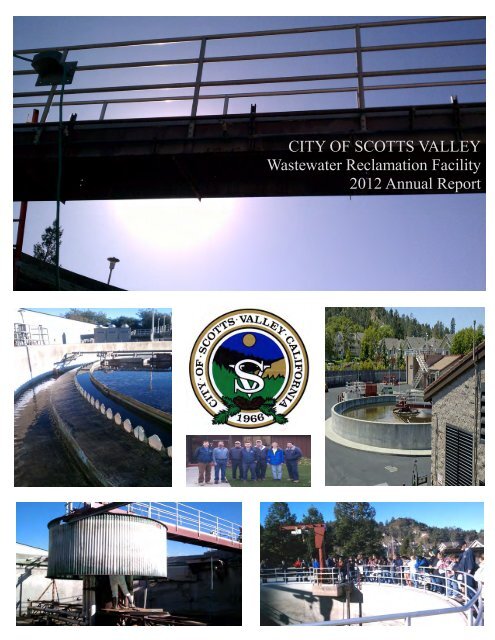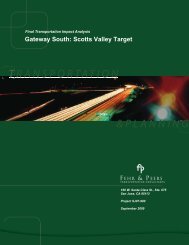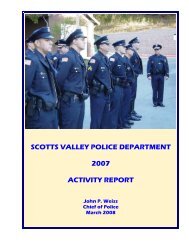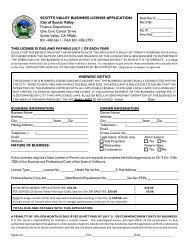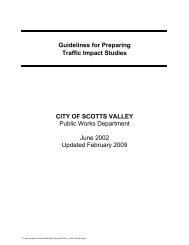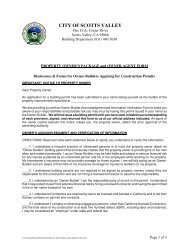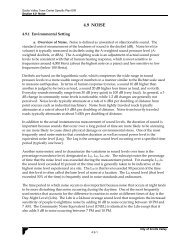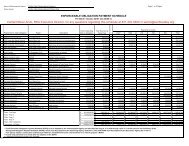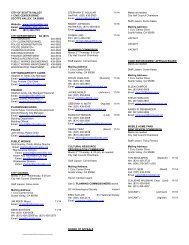Wastewater Annual Report - City of Scotts Valley
Wastewater Annual Report - City of Scotts Valley
Wastewater Annual Report - City of Scotts Valley
Create successful ePaper yourself
Turn your PDF publications into a flip-book with our unique Google optimized e-Paper software.
CITY OF SCOTTS VALLEY<br />
<strong>Wastewater</strong> Reclamation Facility<br />
2012 <strong>Annual</strong> <strong>Report</strong><br />
CITY OF SCOTTS VALLEY<br />
<strong>Wastewater</strong> Reclamation Facility<br />
2011 <strong>Annual</strong> <strong>Report</strong>
CITY OF SCOTTS VALLEY<br />
WASTEWATER TREATMENT FACILITY<br />
ANNUAL REPORT 2012<br />
Plant Summary and Compliance<br />
A record 61.49 million gallons <strong>of</strong> recycled water was used in 2012! That’s nearly seven<br />
million more gallons than in 2011. The <strong>Scotts</strong> <strong>Valley</strong> Water District continues to pursue<br />
additional recycled water users so we anticipate that we will continue to see increased<br />
recycled water usage.<br />
An equipment failure at the close <strong>of</strong> 2012 led to a series <strong>of</strong> four violations for the month<br />
<strong>of</strong> December. A main seal failure in clarifier #3 failed and the clarifier needed to be<br />
taken out <strong>of</strong> service for a short time until repairs could be made. We violated the<br />
effluent 7-day averages for BOD, cBOD, and total suspended solids. These are the first<br />
violations since 2008 when the plant exceeded its TCDD (Dioxin) limit.<br />
For the year 2012, effluent suspended solids averaged 11.0 mg/L (a 95.8% removal<br />
rate), effluent cBOD’s averaged 5 mg/L (a 97.9% removal rate), and effluent BOD’s<br />
averaged 5 mg/L (a 98.1% removal rate). Many thanks to a very knowledgeable and<br />
dedicated treatment plant staff. Without them, the continued high standards the <strong>City</strong><br />
has become accustomed to would not be possible.<br />
We are very proud to announce that Operator II, Tony Alvarez and Senior Laboratory<br />
Analyst, Kati King have been acknowledged by their peers in the Monterey Bay Section<br />
<strong>of</strong> the California Water Environment Association as Operator <strong>of</strong> the Year and Laboratory<br />
Person <strong>of</strong> the Year respectively. Congratulations to Tony and Katy for receiving these<br />
well deserved honors!<br />
Laboratory<br />
The <strong>City</strong> <strong>of</strong> <strong>Scotts</strong> <strong>Valley</strong> <strong>Wastewater</strong> Reclamation Facility Laboratory is busy<br />
accommodating EPA’s Final Methods Update Rule which includes new and revised<br />
wastewater methods and new QA/QC requirements for each analysis. The new<br />
methods update will be enforced during the middle <strong>of</strong> 2013.<br />
The new requirements will cause the analyst to spend more time on each analysis<br />
performed. It will be a challenge for the analyst to streamline the lab as much as<br />
possible in order to be able to complete all aspects <strong>of</strong> the job.<br />
1
Laboratories used during 2012 were:<br />
Inorganic Chemistry and Microbiology: Metals/Inorganic and Organic Chemistry:<br />
<strong>City</strong> <strong>of</strong> <strong>Scotts</strong> <strong>Valley</strong> WWTP<br />
BC Laboratories, Inc.<br />
700 Lundy Lane 4100 Atlas Ct.<br />
<strong>Scotts</strong> <strong>Valley</strong>, CA 95066 Bakersfield, CA 93308<br />
ELAP Certificate No. 1062 ELAP Certificate No. 1186<br />
<strong>Annual</strong> HVWS & Biosolid TCDD:<br />
Frontier Analytical Laboratory<br />
Aquatic Bioassay & Consulting Labs<br />
5172 Hillsdale Circle 29 N. Olive Street<br />
El Dorado Hills, CA 95762 Ventura, CA 93001<br />
ELAP Certificate No. CA02113 ELAP Certificate No. 1907<br />
Lift Stations<br />
The <strong>City</strong> <strong>of</strong> <strong>Scotts</strong> <strong>Valley</strong> owns and operates seven lift stations at various locations<br />
throughout the <strong>City</strong>. All stations are inspected three times each week. During these<br />
routine inspections, hour readings are taken to verify normal running times and flow<br />
throughput. Each pump is individually started and stopped to ensure proper operation,<br />
and wet-wells are visually inspected to confirm water levels with digital level reading on<br />
automatic pump controllers. Once each week, stations equipped with permanent<br />
emergency generators are tested on emergency power to ensure proper operation.<br />
Five stations are equipped with permanent emergency stand-by power. At this time, no<br />
other stations require permanent on-site emergency power, as limited flows allow ample<br />
time for <strong>City</strong> staff to respond to alarm conditions and provide portable generator power<br />
prior to overflows occurring.<br />
All <strong>of</strong> the <strong>City</strong>'s seven stations have back-up pumps and alarm systems that<br />
automatically call 24-hour emergency personnel in case <strong>of</strong> a power outage or high-level<br />
conditions.<br />
Collection System<br />
Following is a summary <strong>of</strong> the three collection system overflows reported by the <strong>City</strong> in<br />
2012:<br />
August 2 – Manhole on El Pueblo Road plugged spilling 1,100 gallons.<br />
Collection system cleaning in the area may have dislodged debris causing the<br />
plug. SSO Event ID 784555.<br />
October 15 – Plumber working on a private lateral released a large clump <strong>of</strong><br />
roots into <strong>City</strong>’s sewer main causing a blockage. An estimated 1,125 gallons<br />
spilled onto Mt. Hermon Road. SSO Event ID 787212.<br />
2
December 23 – Power failure during extreme rain event caused pump failure and<br />
subsequent overflow <strong>of</strong> 500-700 gallons from flow equalization tank at WWTP.<br />
SSO Event ID 789605.<br />
The <strong>City</strong>'s sanitary sewer collection system is made up <strong>of</strong> approximately 40 miles <strong>of</strong><br />
pipeline. <strong>City</strong> crews spend an average <strong>of</strong> two days each week performing preventative<br />
maintenance using a combination vacuum/hydro-jet truck to clean the lines.<br />
Source Control Program<br />
Industrial<br />
There are now two significant industrial users (SIU) in the <strong>City</strong> <strong>of</strong> <strong>Scotts</strong> <strong>Valley</strong>:<br />
ThermoFisher, a categorical metal finishing industry (40 CFR 433.15), and Bay Photo, a<br />
printer and photo processor discharging treated silver-bearing wastewater. During the<br />
month <strong>of</strong> July, results from a test and retest showed that nickel was over the limit by 1.3<br />
mg/L. In August, another retest was completed and the nickel levels remained only<br />
slightly above the limit. A retest in September had results within limits. The annual<br />
inspection was scheduled in August to discuss nickel exceedances. Steps were<br />
discussed for further treatment if the nickel exceedances continue.<br />
Groundwater Remediation: There were two groundwater pump and treat sites<br />
discharging to the sewer in the <strong>City</strong> <strong>of</strong> <strong>Scotts</strong> <strong>Valley</strong>, both under a permit. The<br />
responsible party for the first site is Shell Oil Products and Phillips 66 (formerly<br />
ConocoPhillips) managed by Conestoga-Rovers & Associates (CRA). Discharge began<br />
on March 7, 2008. The site has met all permit conditions to date. The second site is the<br />
Manana Woods Groundwater Well, owned by the San Lorenzo <strong>Valley</strong> Water District.<br />
The District started discharging filter backwash water on August 1, 2011. The backwash<br />
will be treated as necessary to remove pollutants to concentrations below the <strong>City</strong> <strong>of</strong><br />
<strong>Scotts</strong> <strong>Valley</strong> Sanitary Sewer discharge limits. The site has met all permit conditions to<br />
date. Two additional groundwater well sites owned by the <strong>Scotts</strong> <strong>Valley</strong> Water District<br />
will be permitted in early 2013.<br />
All categorical industries and the groundwater pump and treat site in the <strong>City</strong> were<br />
monitored and permitted through the pretreatment program in 2010.<br />
Grease Trap Installation and Maintenance<br />
The fats, oils, and greases (FOG) program is in place with most facilities operating in<br />
compliance with local ordinances. A handful <strong>of</strong> restaurants had minor violations that<br />
were corrected immediately following inspection. The most common area <strong>of</strong> correction<br />
in regards to stormwater and wastewater were improper maintenance <strong>of</strong> exterior waste<br />
containers and enclosure areas. These poor management practices can allow harmful<br />
3
solids and liquids to enter the storm drain; such as tallow and liquids from trash<br />
enclosures. The poor waste management practices included tallow bins covered with<br />
waste oil, oil spills around the drum/bins, trash around dumpsters and tallow bins left<br />
open at all times. The source control inspector worked with the tallow service and the<br />
business owners/managers to address this issue and properly clean or replace and<br />
service the tallow bins and, if necessary, hire a service to clean the enclosures to<br />
prevent the waste from entering the storm drain. Working with the tallow companies<br />
proved to be very beneficial and created an opportunity to express concerns and<br />
challenges on both ends and establish a positive relationship with the tallow service<br />
vendors. The business owners/managers were grateful to have support as well. Source<br />
Control continues to routinely inspect and monitor the conditions <strong>of</strong> the grease<br />
interceptors operating in <strong>Scotts</strong> <strong>Valley</strong>. A Best Environmental Management Practices<br />
pamphlet is being used as a training tool for local restaurant managers and owners.<br />
Maintenance and Repairs<br />
Made repairs to aeration panels<br />
Replaced bearings on backwash blowers for tertiary system<br />
Installed new motor for belt press lower drive<br />
Installed permanent chemical feed system for SulFree at Granite Creek Pump<br />
Station<br />
Rebuilt lower belt hydraulic rams on belt press<br />
Replace screening basket and spiral brush on screening washer<br />
Installed new secondary effluent pH probe<br />
Purchase and installed new SCADA computer<br />
Replaced check valves at Granite Creek Pump Station<br />
Installed new VFD for effluent pump P-10<br />
Installed rebuilt P-8 waste pump<br />
Installed new permanent emergency generator at Granite Creek Pump Station<br />
Clarifier #3 taken out <strong>of</strong> service for repairs (main seal failure)<br />
Rebuilt effluent pumps P-9 and P-10 (P-11 rebuild in progress at end <strong>of</strong> 2012)<br />
Other plant maintenance and repairs were performed as required<br />
O & M Manual<br />
The plant’s main operations and maintenance manual (O&M) was not changed during<br />
2012; however, the plant’s O&M manual library was updated to include new equipment<br />
that was placed into service over the past year. Updating the plant’s O&M manual<br />
takes place on an ongoing basis. We have one O&M manual that is used for<br />
operational guidelines and minor service to plant equipment. We also catalog individual<br />
O&M’s for every piece <strong>of</strong> equipment in place at the treatment plant, collection system,<br />
and lift stations.<br />
4
Training<br />
All staff was retrained in the biannual Red Cross Adult CPR and Standard First<br />
Aid Certification Program.<br />
All staff participates in the plant’s in-house safety/training meetings that are<br />
conducted every other Wednesday throughout the year.<br />
All Operations and Laboratory staff participated in several one-day training classes<br />
and seminars related to wastewater treatment, laboratory and maintenance.<br />
Public Education/Outreach<br />
The <strong>Scotts</strong> <strong>Valley</strong> Green Schools Program was developed in 2010 to provide<br />
environmental education to <strong>Scotts</strong> <strong>Valley</strong> students and to encourage the institution <strong>of</strong><br />
best environmental practices at the schools following the model <strong>of</strong> the Green Business<br />
Program. The Green Schools Program was funded by the <strong>City</strong> <strong>of</strong> <strong>Scotts</strong> <strong>Valley</strong>, and<br />
<strong>of</strong>fered free to the area schools. It was <strong>of</strong>fered to the ninth graders at <strong>Scotts</strong> <strong>Valley</strong><br />
High School, and to the fifth graders at Vine Hill Elementary School and Baymonte<br />
Christian School, two grade levels in which ecology concepts are taught. In 2010-2011,<br />
two series <strong>of</strong> presentations and three community service events were <strong>of</strong>fered at <strong>Scotts</strong><br />
<strong>Valley</strong> High School. Two series <strong>of</strong> presentations were also <strong>of</strong>fered at Vine Hill<br />
Elementary, along with a Save Our Shores presentation, and the formation <strong>of</strong> an<br />
Environmental Leadership Council. In 2012, due to a cutback in funds, only one set <strong>of</strong><br />
presentations were given at Vine Hill Elementary.<br />
The 2012 Vine Hill program consisted <strong>of</strong> a one-hour program on water issues to 80 fifth<br />
graders on October 26, 2012. The program addressed two areas: 1) the source <strong>of</strong><br />
water in <strong>Scotts</strong> <strong>Valley</strong> and the importance <strong>of</strong> water conservation measures, and 2)<br />
where water goes (sewer, septic systems, and the storm drain system), and the<br />
necessity <strong>of</strong> keeping storm drain water clean. LeAnne Ravinale from the <strong>Scotts</strong> <strong>Valley</strong><br />
Water District taught the first part <strong>of</strong> the program, using a model <strong>of</strong> an aquifer, and<br />
playing charades to act out water conservation strategies. The second part <strong>of</strong> the<br />
program was taught by Sheila Peck from the Green Schools Program. For this piece,<br />
students designed their own storm drain placards to explain why storm drains should be<br />
kept clean for plants and animals downstream. A second program at Vine Hill, as well<br />
as a two-day program at <strong>Scotts</strong> <strong>Valley</strong> High School, is planned for spring, 2013.<br />
The Monterey Bay Area Green Business Program continues to thrive. Goals <strong>of</strong> the<br />
Green Business Program include promoting pollution prevention, waste minimization,<br />
and implementing best management practices that go above and beyond the regulatory<br />
standards. Since its launch in July, 2004, the program has developed nineteen different<br />
business certification sectors, including: restaurants, plumbers, <strong>of</strong>fice/retail facilities,<br />
hotels/hospitality services, custodial companies, beauty salons, laundromats, wineries,<br />
painters, and landscapers, property management/multi-family dwellings, schools,<br />
medical facilities, garment cleaners, vehicle service facilities, auto body shops, printers,<br />
5
contractors/remodelers, and pharmacies. A significant portion <strong>of</strong> the program for<br />
restaurants, hotels, and plumbers is dedicated to minimizing discharges <strong>of</strong> fats, oils, and<br />
greases (FOG) into the sanitary sewer. The program is supported by a database<br />
launched in 2010, which allow it to collect metrics on water and energy savings, and<br />
pollution and waste reduction, and so assess the program’s impacts. Nineteen<br />
businesses have been certified to date in <strong>Scotts</strong> <strong>Valley</strong>. These businesses have been<br />
advertised in a local paper and will be advertised again in the spring.<br />
Having been certified for more than three years, several <strong>Scotts</strong> <strong>Valley</strong> green businesses<br />
underwent “recertification” in 2012. One such organization that demonstrated continued<br />
green achievement was the Central California Alliance for Health. With approximately<br />
200 employees, this group has made a significant and impressive conservation impact.<br />
Since it became certified in 2009, it has reduced CO2 emissions by 886,437 lbs, saved<br />
655,053 kWh <strong>of</strong> energy, 664,891 gallons <strong>of</strong> water, and 7,138 gallons <strong>of</strong> gas, and<br />
diverted 903,458 lbs <strong>of</strong> solid waste from the landfill.<br />
<strong>Scotts</strong> <strong>Valley</strong> <strong>City</strong> Staff, in collaboration with the County <strong>of</strong> Santa Cruz and other <strong>City</strong><br />
agencies, were successful in obtaining a grant in 2008 from the California Integrated<br />
Waste Management Board (CIWMB) in order to implement a pharmaceutical and<br />
sharps disposal program. Since that time, the Sharp Solutions for Home Medicines<br />
Program has provided a convenient and permanent system to dispose <strong>of</strong> homegenerated<br />
used sharps and unwanted pharmaceuticals in the County <strong>of</strong> Santa Cruz.<br />
The County has established 33 convenient and well-publicized drop-<strong>of</strong>f locations,<br />
primarily at pharmacies, throughout the region.<br />
Since 2010, the Palo Alto Medical Foundation (PAMF) has accepted medicines from its<br />
patients at its clinic in <strong>Scotts</strong> <strong>Valley</strong>. PAMF now <strong>of</strong>fers this service at all 5 <strong>of</strong> its major<br />
clinics in Santa Cruz County. Since PAMF’s program is limited to its patients and it<br />
covers all costs <strong>of</strong> the program, collection data from its sites is not available.<br />
From July 2008 through December 2012, over 73,000 pounds <strong>of</strong> sharps and<br />
pharmaceuticals have been collected and diverted from county landfills and water<br />
systems, thus reducing water pollution and public health risks. The three take-back<br />
sites in <strong>Scotts</strong> <strong>Valley</strong> alone collected 1,114 pounds <strong>of</strong> sharps and 1,937 pounds <strong>of</strong><br />
medicines during 2012. Compared to countywide data, these figures amount to 10%<br />
and 18%, respectively, <strong>of</strong> the two medical wastes collected in a city that comprises only<br />
4.4% <strong>of</strong> county population.<br />
The <strong>Scotts</strong> <strong>Valley</strong> Police Department, in cooperation with the County Sheriff’s Office,<br />
participated in the Federal Department <strong>of</strong> Justice’s National Drug Take-Back Days on<br />
April 28 and September 29, 2012. All drugs, including controlled substances, are<br />
allowed at these events. Residents turned in 120 pounds <strong>of</strong> drugs at the April collection<br />
day and 10 pounds in September. The Police Department plans to continue to<br />
participate in these events, and they are also considering a proposal from Sharp<br />
Solutions to become a permanent drug take-back site.<br />
6
Electronic Waste: On Saturday, September 15, 2012, the <strong>City</strong> <strong>of</strong> <strong>Scotts</strong> <strong>Valley</strong><br />
conducted its 10 th annual e-waste collection event. The <strong>City</strong> collected nearly 20,000<br />
pounds <strong>of</strong> electronics, mostly in the form <strong>of</strong> computers, monitors and television sets,<br />
from over 300 participants. These items are now banned from landfill disposal because<br />
<strong>of</strong> their hazardous material content <strong>of</strong> lead, mercury, and other heavy metals.<br />
Appliance Collection: The <strong>City</strong> <strong>of</strong> <strong>Scotts</strong> <strong>Valley</strong> held its 9 th annual Appliance<br />
Collection Event on Saturday, October 13. In the previous eight years the event<br />
included tire collection as well, but the <strong>City</strong> lost its grant to pay for tire disposal/recycling<br />
and is no longer able to <strong>of</strong>fer that service. 45 participants dropped <strong>of</strong>f a total <strong>of</strong> 5 water<br />
heaters, 3 washers, 4 dryers, 4 oven/stoves, 10 refrigerators and 20 misc. small<br />
appliances. Scrap metal from appliances was shredded, melted and made into new<br />
metal products.<br />
To address the new Mandatory Commercial Recycling legislation, Assembly Bill 341<br />
that went into effect July 1, 2012, the source control inspector conducted recycling<br />
outreach at all restaurants, auto body shops and auto repair shops. The inspector used<br />
the inspections as an opportunity to outreach and educate business owners and<br />
managers about the new legislation and explain their responsibility. Each business was<br />
given a Bilingual Recycling Poster to put up at their business indicating the various<br />
recyclable and non recyclable items.<br />
On an annual basis, the treatment plant staff provides a number <strong>of</strong> ongoing public<br />
outreach/education services. Some <strong>of</strong> those services include:<br />
Oil Recycling: As a member <strong>of</strong> the County's regional oil recycling program, the<br />
<strong>City</strong> distributes oil recycling containers to local automotive supply stores where<br />
they are distributed to residents at no cost. The 2.5 gallon used oil containers<br />
have labels containing information on proper disposal practices and can be used<br />
throughout the county in any curbside collection program as part <strong>of</strong> the integrated<br />
regional program.<br />
As always, plant tours are encouraged and given upon request to any person or<br />
group wishing to learn about the treatment process. Several individual and group<br />
tours were given in 2012.<br />
7
NPDES PERMIT EFFLUENT VIOLATIONS 2003-2012<br />
2003 2004 2005 2006 2007 2008 2009 2010 2011 2012<br />
January 0 0 0 0 0 0 0 0 0 0<br />
February 0 0 0 0 0 0 0 0 0 0<br />
March 0 0 0 0 0 0 0 0 0 0<br />
April 0 0 0 0 0 0 0 0 0 0<br />
May 0 0 0 0 0 0 0 0 0 0<br />
June 0 0 0 0 0 0 0 0 0 0<br />
July 0 0 0 0 0 0 0 0 0 0<br />
August 0 0 0 0 0 1* 0 0 0 0<br />
September 0 0 0 0 0 0 0 0 0 0<br />
October 0 0 0 0 0 0 0 0 0 0<br />
November 0 0 0 0 0 0 0 0 0 0<br />
December 0 0 0 0 0 0 0 0 0 4<br />
Total 0 0 0 0 0 1 0 0 0 4<br />
*TCDD<br />
Eff. Weekly<br />
Avg.BOD<br />
CBOD,TSS<br />
sett.solid<br />
8
TABLE 1<br />
2012 PLANT FLOW AND<br />
RAINFALL<br />
Total Effluent Effluent Recycled<br />
Plant Flow Daily Flow Inst. Max. Total Flow Rainfall<br />
Million<br />
Gallons<br />
Eff.+Rec.MGD MGD MGD<br />
Inches<br />
Mo. Total Mo. Total (peak) Mo. Total (Total)<br />
January 26.073 23.814 3.52 2.259 7.57<br />
February 22.911 20.369 2.33 2.542 2.37<br />
March 31.283 30.193 3.54 1.090 12.87<br />
April 26.722 25.160 2.53 1.562 3.58<br />
May 24.659 16.511 2.13 8.148 0.03<br />
June 23.288 13.488 3.10 9.800 0.17<br />
July 23.544 13.469 3.54 10.075 0.02<br />
August 23.375 12.721 1.74 10.654 0.00<br />
September 22.129 14.096 2.10 8.033 0.00<br />
October 23.099 17.917 2.57 5.182 1.59<br />
November 25.709 23.932 3.40 1.777 10.80<br />
December 32.884 32.518 3.58 0.366 13.67<br />
Total 305.68 244.19 61.49 52.67<br />
Average 25.47 20.35 2.84 5.12 4.39<br />
Maximum 32.88 32.52 3.58 10.65 13.67<br />
Minimum 22.13 12.72 1.74 0.37 0.00<br />
ADDWF, MGD 0.765<br />
Eff + Recycle<br />
9
TABLE 2<br />
2012 Influent & Effluent Suspended Solids<br />
Influent Effluent Effluent Percent<br />
mg/L mg/L lb/day Removal<br />
January 262 7 44 97.4%<br />
February 266 4 27 98.4%<br />
March 233 6 63 97.4%<br />
April 254 7 54 97.1%<br />
May 271 10 29 96.3%<br />
June 276 14 60 94.8%<br />
July 262 11 36 95.7%<br />
August 275 9 33 96.9%<br />
September 273 7 23 97.3%<br />
October 283 9 40 96.7%<br />
November 269 14 105 94.4%<br />
December 222 30 199 86.6%<br />
Average 262 11 59 95.8%<br />
Maximum 283 30 199 98.4%<br />
Minimum 222 4 23 86.6%<br />
10
TABLE 3<br />
2012 Influent & Effluent BOD & cBOD<br />
Influent Effluent Effluent BOD Influent Effluent Effluent cBOD<br />
BOD BOD BOD Percent cBOD cBOD cBOD Percent<br />
mg/L mg/L lb/day Removal mg/L mg/L lb/day Removal<br />
January 288 4 25 98.7% 239 3 21 98.7%<br />
February 308 3 19 99.1% 220 2 17 98.8%<br />
March 221 3 22 98.5% 173 3 18 98.4%<br />
April 260 5 36 97.9% 218 5 34 97.7%<br />
May 279 5 32 98.3% 226 4 25 98.4%<br />
June 293 4 30 98.5% 240 4 27 98.3%<br />
July 310 4 28 98.6% 248 3 22 98.6%<br />
August 331 4 28 98.8% 276 3 23 98.8%<br />
September 295 3 20 99.0% 253 2 17 99.0%<br />
October 300 4 27 98.6% 242 3 23 98.6%<br />
November 317 5 35 98.3% 254 4 28 98.4%<br />
December 241 18 123 92.9% 188 17 116 91.3%<br />
Average 287 5 36 98.1% 231 5 31 97.9%<br />
Maximum 331 18 123 99.1% 276 17 116 99.0%<br />
Minimum 221 3 19 92.9% 173 2 17 91.3%<br />
11
TABLE 4<br />
2012 Tertiary Effluent Nitrogen<br />
Tertiary Tertiary Tertiary Tertiary Influent Tertiary<br />
Ammonia<br />
Organic<br />
N Nitrate Nitrite Total N Nitrogen<br />
mg/L mg/L mg/L mg/L mg/L Removal<br />
as N as N as N as N as N Percent<br />
January 0.06 1.0 5.8 < 0.1 76 88.3<br />
February 0.04 0.7 3.1 < 0.1 72 90.0<br />
March 0.05 0.7 1.4 < 0.1 62 86.4<br />
April 1.16 0.5 < 1.0 < 0.1 64 84.8<br />
May 0.08 1.0 2.8 < 0.1 77 87.2<br />
June 0.09 1.0 4.5 < 0.1 76 86.2<br />
July 0.07 0.9 5.5 < 0.1 75 84.0<br />
August 0.08 1.0 4.6 < 0.1 78 90.8<br />
September 0.07 0.8 3.4 < 0.1 73 90.4<br />
October 0.07 0.9 2.5 < 0.1 79 88.4<br />
November 0.07 0.9 3.1 < 0.1 61 91.8<br />
December 0.90 0.8 1.1 < 0.1 58 91.5<br />
Average 0.23 0.8 3.2 < 0.1 70.7 88.3<br />
Maximum 1.16 1.0 5.8 < 0.1 78.6 91.8<br />
Minimum 0.04 0.5 1.0 < 0.1 58.0 84.0<br />
12
TABLE 5<br />
2012 Influent & Effluent pH and<br />
Effluent Turbidity, Settleable Solids, and Oil & Grease<br />
Influent Effluent Effluent Effluent Effluent Effluent<br />
Oil &<br />
Oil &<br />
pH pH Turbidity Settleable Grease<br />
Grease<br />
Std Units Std Units NTU Solids mg/L lb/day<br />
ml/L<br />
January 8.2 7.2 2.7 < 0.1 < 5 < 34<br />
February 8.2 7.3 2.8 < 0.1 < 5 < 34<br />
March 8.1 7.2 3.3 < 0.1 < 5 < 34<br />
April 8.1 7.2 7.8 < 0.1 < 5 < 34<br />
May 8.1 7.2 6.7 < 0.1 < 5 < 34<br />
June 8.1 7.2 5.0 < 0.1 < 5 < 34<br />
July 8.1 7.2 4.0 < 0.1 < 5 < 34<br />
August 8.1 7.2 3.1 < 0.1 < 5 < 34<br />
September 8.2 7.2 2.6 < 0.1 < 5 < 34<br />
October 8.2 7.3 3.0 < 0.1 < 5 < 34<br />
November 8.2 7.2 8.5 < 0.1 < 5 < 34<br />
December 8.0 7.1 8.0 < 0.1 < 5 < 34<br />
Average 8.1 7.2 4.8 < 0.1 < 5.0 < 34<br />
Maximum 8.2 7.3 8.5 < 0.1 < 5.0 < 34<br />
Minimum 8.0 7.1 2.6 < 0.1 < 4.6 < 34<br />
13
TABLE 6<br />
2012 Effluent Chlorine Residual and<br />
Bacteriological Quality<br />
Chlorine Total Fecal<br />
Enterococcu<br />
Residual Coliform Coliform<br />
s<br />
mg/L MPN/100mL MPN/100mL MPN/100mL<br />
@Santa Cruz<br />
January < 0.01 970 < 200 39<br />
February < 0.01 690 < 200 10<br />
March < 0.01 2000 < 200 18<br />
April < 0.01 1110 < 280 61<br />
May < 0.01 2083 217 42<br />
June < 0.01 3780 1210 32<br />
July < 0.01 2440 520 989<br />
August < 0.01 15430 890 284<br />
September < 0.01 2290 240 255<br />
October < 0.01 10620 < 2280 287<br />
November < 0.01 3110 < 310 89<br />
December < 0.01 6670 < 690 96<br />
Geometric < 0.01 2,790 < 422 < 83<br />
Maximum < 0.01 15,430 1,160 989<br />
Minimum < 0.01 690 < 200 10<br />
14
TABLE 7<br />
2012 Sludge<br />
Wasting<br />
WAS WAS WAS Hours Sludge Sludge<br />
Flow Percent<br />
Metric<br />
Tons Pressed Cake Hauled<br />
MGD Solids per month per/mnth<br />
%<br />
Solids Tons/mnth<br />
(dry wt)<br />
(dry wt)<br />
January 0.6987 0.92 22.3 123 15.3 29.0<br />
February 0.7558 0.92 25.4 125 15.0 27.1<br />
March 0.6484 0.97 25.6 119 15.2 31.0<br />
April 0.6308 1.03 29.2 127 15.5 27.5<br />
May 0.6694 0.94 26.0 135 15.4 26.0<br />
June 0.5297 0.98 28.6 105 15.7 26.9<br />
July 0.7142 0.99 30.8 143 15.1 24.3<br />
August 0.9750 0.90 25.3 128 14.3 26.2<br />
September 0.6266 0.89 26.3 123 14.8 21.8<br />
October 0.7083 0.80 20.1 139 15.0 24.8<br />
November 0.6425 0.80 20.1 128 14.4 26.2<br />
December 0.7272 0.74 15.9 140 14.7 29.4<br />
Total 8.327 295.5 1,534 320.2<br />
Average 0.694 0.91 24.6 128 15.0 26.7<br />
Maximum 0.975 1.03 30.8 143 15.7 31.0<br />
Minimum 0.530 0.74 15.9 105 14.3 21.8<br />
15
TABLE 8<br />
2012 Plant Operating Parameters<br />
Aerator Clarifier Total RAS MLSS<br />
Clar.<br />
SS MCRT F/M SVI<br />
lbs lbs lbs mg/L mg/L mg/L 7-day 7-day Ratio<br />
January 13727 9385 23,112 9467 5457 2217.8 10.0 0.19 168<br />
February 13813 8798 22,610 9015 5491 2079.0 8.2 0.19 167<br />
March 13693 9901 23,594 9387 5444 2339.8 8.9 0.22 167<br />
April 14805 12542 27,347 10011 5886 2963.7 10.1 0.19 154<br />
May 13972 9589 23,561 9263 5555 2265.9 8.9 0.19 160<br />
June 15083 11882 26,965 9501 5997 2807.9 11.1 0.17 157<br />
July 13682 9905 23,587 8725 5439 2340.6 8.1 0.18 170<br />
August 13180 9021 22,201 8614 5240 2131.7 8.0 0.19 172<br />
September 12559 10505 23,064 8053 4993 2482.4 8.2 0.20 190<br />
October 12573 9605 22,178 8106 4999 2269.8 9.0 0.20 194<br />
November 11957 11043 23,001 7754 4754 2609.7 9.0 0.21 205<br />
December 10249 14003 24,252 6990 4075 3309.0 9.4 0.35 233<br />
Average 13,274 10,515 23,789 8,741 5,277 2,485 9.1 0.21 178<br />
Maximum 15,083 14,003 27,347 10,011 5,997 3,309 11.1 0.35 233<br />
Minimum 10,249 8,798 22,178 6,990 4,075 2,079 8.0 0.17 154<br />
16
FIGURE 1<br />
FIGURE 2<br />
17
FIGURE 3<br />
FIGURE 4<br />
18
FIGURE 5<br />
FIGURE 6<br />
19
FIGURE 7<br />
FIGURE 8<br />
20
FIGURE 9<br />
FIGURE 10<br />
21
FIGURE 11<br />
FIGURE 12<br />
22
FIGURE 13<br />
FIGURE 14<br />
23
FIGURE 15<br />
FIGURE 16<br />
24
FIGURE 17<br />
FIGURE 18<br />
25
FIGURE 19<br />
FIGURE 20<br />
26


